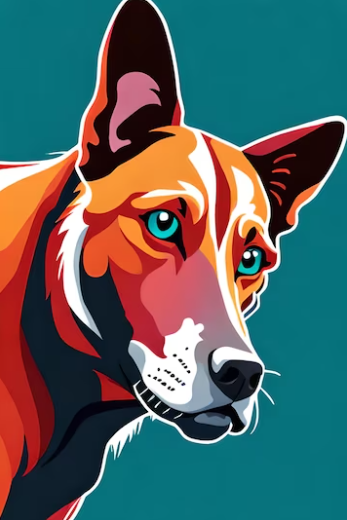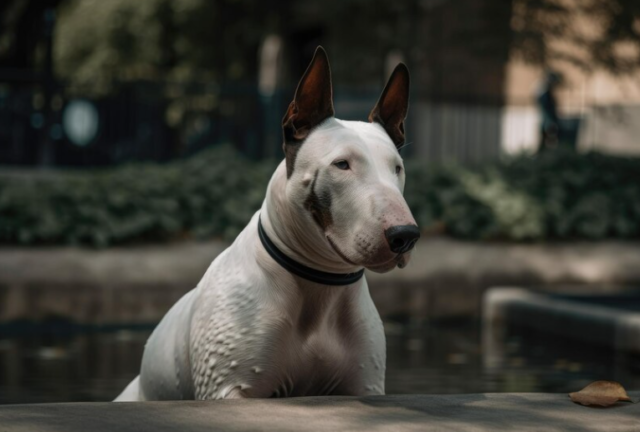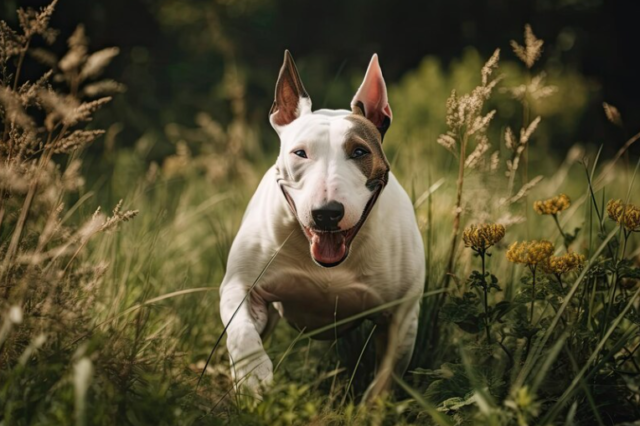Introduction
The English dog breed known as the medium-sized bull terrier has a distinctive “egg-shaped” head and short, silky hair. It also has quadrilateral eyes and small, pointed ears. The target dog breed has a strong physique and lots of muscle. They can be eccentric and stubborn at times, but they generally make entertaining and engaging company. He is commonly described as “the kid in the dog suit”.
Terrier breed group overview
| 21 to 22 inches in height | 50 to 70-pound range |
| COAT: Brief and slick | Nearly any color, such as white, red, fawn, black, blue, or brindle, is acceptable for coats. |
| PERIOD OF LIFE: 12 to 13 years | TEMPERAMENT: Warm, vivacious, and amiable |
| NO HYPOALLERGENIC | British origin |
Characteristics of the Bull Terrier
Bull Terriers often have a positive attitude and are entertaining. It often gets on well with people but may not be a fan of dogs. The Bull Terrier’s high level of energy and demand for play also affects its temperament.
| Affection Level | High |
| Friendliness | High |
| Kid-Friendly | Medium |
| Pet-Friendly | Low |
| Exercise Needs | High |
| Playfulness | High |
| Energy Level | High |
| Trainability | Medium |
| Intelligence | Medium |
| Tendency to Bark | Medium |
| Amount of Shedding | Medium |
The History of the Bull Terrier
Animal cruelty and bloodshed were common in Britain around the 13th century. A bulldog and a tied bull are engaged in a fight in a sport known as “bull-baiting” and “target dog breed”, with spectators betting on the outcome.
In the 1800s, Britain outlawed such bloodsports. however, others chose to use them underground. Instead of focusing on the more visible bull-baiting, he focused on dogfighting. Additionally, they mixed their bulldogs with other terriers to produce more ferocious and agile dogs. This led to the creation of several breeds including the Bull Terrier.
When dog fighting declined in the mid-1800s, breeders attempted to improve it to make the Bull Terrier a more companionable dog. They were bred to have a more endearing temperament and less scruffy appearance. It will take many more years for the dog to develop its recognizable folded head.
In 1885, the American Kennel Club officially recognized the breed. There have also been some famous Bull Terriers in the past. President Theodore Roosevelt had a Bull Terrier. Bull terriers Bullseye and Spuds Mackenzie have also advertised Target and Bud Light beers.
Care for Bull Terriers
Bull Terriers don’t require a lot of grooming and should be given some daily exercise. It is also necessary to introduce early socialization and training initiatives for children.
Exercise
Give your Bull Terrier at least one to two hours of physical activity each day to help him burn off high levels of mental and physical energy. In addition to jogging, excursions, games of fetch and other activities, several walks are recommended every day. Playing with puzzle toys will help your dog get some cerebral activity. Canine activities such as agility and tracking can also activate both the body and the mind.
When taking your Bull Terrier outside, keep him on a leash or inside a secure area because not all Bull Terriers will be friendly if they encounter another dog. The Bull Terrier’s short coat doesn’t provide much insulation from the cold. The best course of action is to limit your dog’s outdoor training in winter and think about getting your dog a coat or jumper.
Grooming
The Bull Terrier’s incredibly short, silky coat requires very little maintenance. Simple grooming is all that is needed. Aim to brush your pet once a week, using a soft-bristle brush or grooming mitt, to remove loose fur and distribute skin oils. In spring and autumn, when your dog may shed more, you may need to brush your dog more regularly to keep up with the loose fur.
Depending on how soiled it gets, wash your dog every month or so. Additionally, inspect the animal’s nails every month to determine if they need trimming. Additionally, check the animal’s ears at least once a week for wax accumulation, dirt and discomfort. And try to wash its teeth daily.
Training
Socialization and thorough obedience training are essential to controlling your Bull Terrier. It’s important to spot bad behaviors early if you want to prevent them from becoming bad habits. Training a Bull Terrier can be challenging when it comes to learning. Employ only positive reinforcement strategies. They often perform at their best when training sessions are more like play than labor.
Additionally, from a young age, try to socialize your dog with other people and dogs to increase his comfort and confidence. Your bull terrier’s behavior can be greatly improved by positive encounters. But because of the breed’s fighting heritage, some bull terriers find it difficult to feel comfortable among other dogs, especially strange dogs. As a result, there is a chance for aggression.
Typical Health Issues
Bull Terriers are generally in good health, however, they can develop some inherited conditions, such as:
- Deafness
- kidney disease
- heart condition
- loose patella
- Problems with the skin and coat, including allergies

Nutrition and Diet
Maintain constant access to fresh water for your dog. And feed your dog food that is excellent in quality and nutritionally balanced. Bull terriers in particular need an adequate calcium intake, especially when they are puppies, to support bone development. To avoid overeating, two-meter meals are often offered twice a day. Before making any changes to the type or amount of your dog’s food, you should always speak with your veterinarian to make sure you are meeting his individual needs.
Places to Purchase or Adopt a Bull Terrier
A fairly popular dog breed is the Bull Terrier. So if you are looking to get a bull terrier, be sure to search your neighborhood animal shelters and rescue organizations for a dog in need of a home. Expect to pay between $500 and $35,003 for a puppy from a reputable breeder, however, prices can vary greatly.
Check out the following for further details to assist you in finding a bull terrier:
- American Bull Terrier Club
- Rescue of Bull Terriers
Bull Terrier (Target Dog Breed) Overview
Pros
- Positives Playful and affectionate.
- needed for basic grooming.
- For families with older kids, it may be beneficial.
Cons
-
Typically not friendly with other dogs.
-
When it comes to training, can be recalcitrant.
-
Necessitates frequent, hard exercise.
In conclusion, the Bull Terrier is an energetic and engaging target dog breed, often referred to as “the kid in the dog suit.” With proper care, socialization, and training, they can become loving family companions. It is important to meet their exercise needs, provide adequate grooming, and address their specific health concerns. Whether through adoption or reputable breeders, welcoming a bull terrier into your home can bring joy and companionship to your life.
FAQs
Q1: Are target dog breeds suitable for families with children?
Many target dog breeds, such as golden retrievers and Labrador retrievers, are known for their excellent temperaments and are good with children. However, it is important to supervise interactions between dogs and children and to teach both how to interact safely and respectfully.
Q2: How can I ensure the well-being and happiness of my target dog breed?
Regular exercise, mental stimulation, a nutritious diet, socialization and regular veterinary care are essential to the overall well-being and happiness of your target dog breed.
Q3: Can target dog breeds adapt to apartment living?
Yes, some target dog breeds, such as the Cavalier King Charles Spaniel and the Shih Tzu, can adapt well to apartment living, provided they receive sufficient exercise and mental stimulation.
Q4: Do target dog breeds require specialized training?
Depending on the breed and their intended role, some target dog breeds may benefit from specialized training. Consult with professional trainers to determine the training needs specific to your chosen breed.
Q5: How long do target dog breeds typically live?
The lifespan of target dog breeds varies depending on the breed and other factors. On average, most target dog breeds live between 10 and 15 years. However, some breeds can live longer with proper care and attention.
Q6: What breed is the Target dog?
The Target dog, known as Bullseye, is a Bull Terrier breed.
Q7: Is Spuds MacKenzie the Target dog?
No, Spuds MacKenzie was not the Target dog. Spuds MacKenzie was a Bull Terrier who gained fame in the 1980s as the mascot for Bud Light.
Q8: Is a Pitbull a Bull Terrier?
While Pitbulls and Bull Terriers may share some physical similarities, they are distinct breeds with their own characteristics and temperaments.
Q9: What happened to the original Target dog?
The original Target dog, Bullseye, is still the beloved mascot of Target.
Read also
- A Convenient Solution for Dog Food Storage Container 50 lbs of Kibble
- Effective Strategies to Stop a Dog from Jumping Up | Expert Advice
- Lab Shiba Inu Mix: No 1 Unique and Lovable Canine Companion!
- Why Is My Dog Barking at Nothing?: Unraveling the Mystery
- Cushing Disease Dog Diet: How to Manage Your Dog’s Health
- Crusty White Dog Breed: Unveiling the Unique Characteristics
- Tough Dog Toys: Durable Toys for Your Pup | Buy Today
- Top 10 Must-Have Dog Camping Gear for Your Next Adventure
- Choose the Best Dog Food for Your Picky Eaters Needs
- Find the Best Dog Food for Your Huskies
- Best Dog Food for Allergies and Yeast Infections
- Best Way to Give a Dog a Pill: A Guide to Making Medication Time Easier
- Discover the Best Dog Food for German Shepherd Puppy: Unveiling the Ultimate Guide!
- Best Dog Food for French Bulldogs: Secrets Revealed
- Best Dog Food for Seniors
- Types of Pitbulls: A Comprehensive Guide
- Best Dog Food for Goldendoodles: Your Guide to Optimal Nutrition
- Italian Greyhound Mix Chihuahua New Breed Info & Care [2023]
- Barking Shock Collars Suitable for all Dogs?
- Stop Dog Nail Bleeding Fast: 5 Easy Home Remedies





